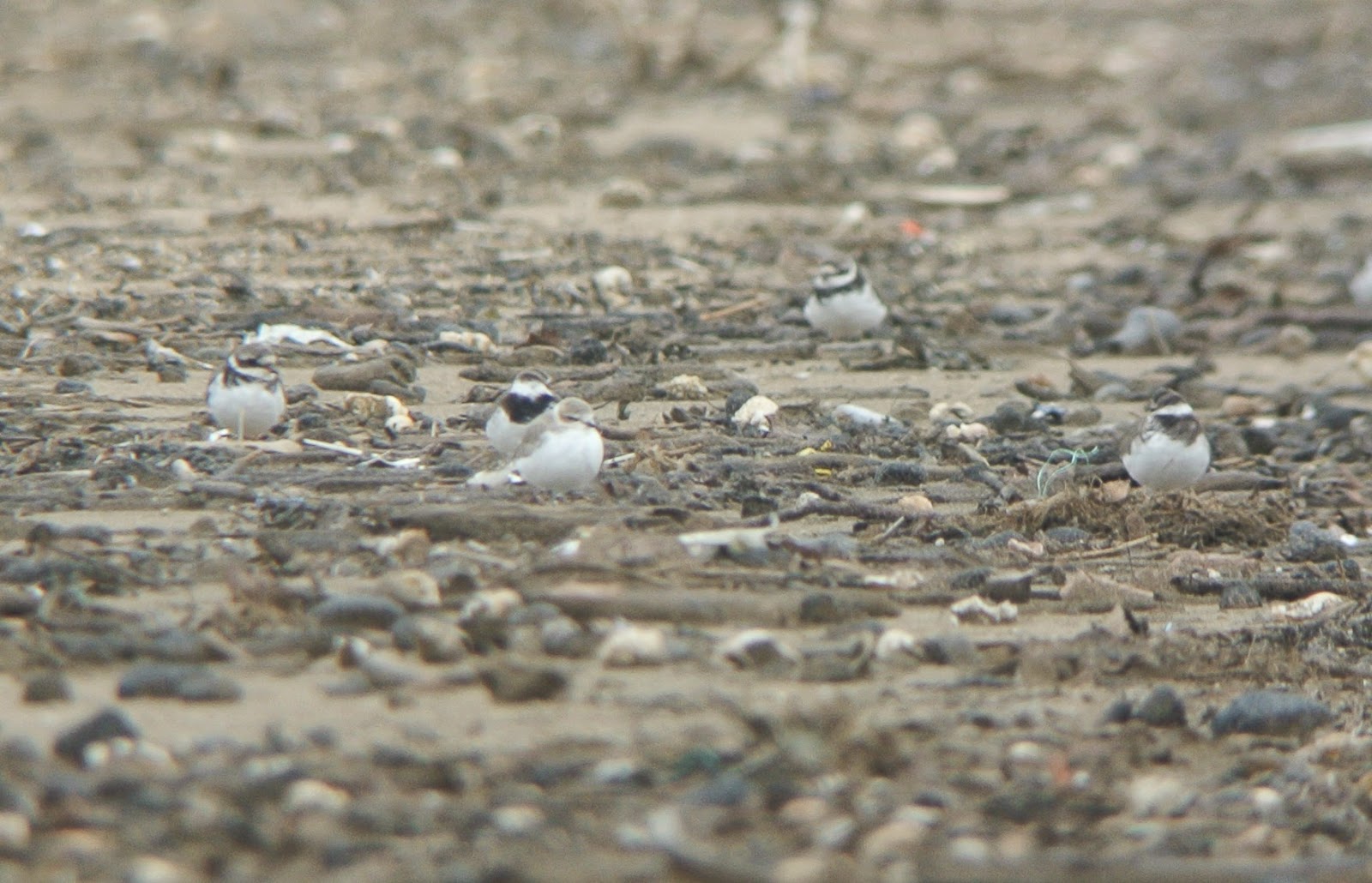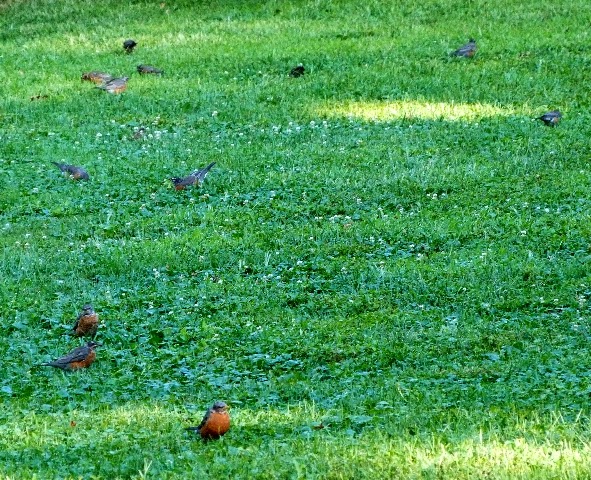Myself &
Mrs PJ recently spent a very enjoyable 2 weeks across the pond with 5
days in New York followed by a road trip into New England visiting
Massachucetts & New Hampshire. My birding was mainly centred around 4
sites, Central Park in NY, The White Mountains in NH, Plum Island in
Mass & Cape Cod also in Mass.
CENTRAL PARK, NEW YORK
First
morning I was up at first light and off to my new temporary local patch
- Central Park. Our hotel on Madison Ave had been chosen specially, due
to its close proximity to the Park so I was birding within minutes ' Coffee ' still in hand.
There
were 2 things I noticed straight away that were different from my local
patch at home, No 1 was that nobody had ever told me to ''have a nice
day'' up the Void & No 2 was that there were birds here, lots and
lots of birds and my initial impression was that most of them were
American Robins !!
I'm
not joking, there were 100's of them, everywhere you looked there were
literally 'flocks' of them. Catbirds were also common with Mourning
Doves and a few Grackles thrown in but it was the migrants I was after
so I started to check a few likely looking areas. The first area I
checked didn't disappoint, as I walked through I disturbed 2 birds that
had been feeding on the grass underneath some over hanging vegetation.
They didn't fly far so I located them quite quickly - 2 Oven birds
!! what a start and they looked a fair bit healthier than the last one I
saw on the Scilly Isles back in 2004. These were closely followed by a
Warbling Vireo which
was a new bird for me. Other highlights from my first morning were - 3
Common Yellowthroats, 1 American Redstart, 1 Red Breasted Nuthatch, 1
Carolina Wren, 1 Downy Woodpecker & a Rose Breasted Grosbeak.
Walking
back to the hotel I bumped into Joan Rivers' funeral, Oven bird and
Sarah Jessica Parker all before breakfast - only in New York !!
American Robin
American Robin flock
Warbling Vireo
Yellowthroat
My
second morning and I decided to tag along with the 'famous' Bob's
birding tours of Central Park, mainly to suss out out where the best
migrant hotspots were. The man himself was away but his replacement,
Deb, knew her stuff and a very enjoyable 2 - 3 hours were spent
wandering around the 'Rambles' which is near 'Strawberry Fields' the
John Lennon memorial opposite the Dakota building where the great man
was shot.
By
the end of the morning my notebook was crammed full of quality birds
including - 3 Baltimore Orioles, 1 Yellow Warbler, 1 Northern Parula, 1
Black & White Warbler, 1 American Redstart, loads of Yellowthroats, 2
Rose Breasted Grosbeaks, 3 Red Eyed Vireos, 1 Cedar Waxwing, 1
Swainsons Thrush and best of all 1 Wood Thrush.
The Birding during the remainder of my stay in NY didn't quite live up to my first 2 mornings but I did add Song Sparrow, Eastern Phoebe, Wood duck, Cardinal plus loads more Yellowthroats to the list.
Baltimore Orioles
Blue Jay
Red-eyed Vireo
Wood Duck
THE WHITE MOUNTAINS, NEW HAMPSHIRE
Early on the final morning in NY we took a cab back to JFK and picked up the hire car. Once again the American Sat Nav I had bought on a previous
trip saved our marriage, those things really are indispensable as
Important as your bins and a fresh pair of underpants.
It
was nice to leave the intensity of the city behind and get out into the
countryside. The drive up to the mountains took a little longer than
expected, about 6 hours in total but by mid afternoon we were pulling up
outside our lodge in Jackson. What a fantastic location it was, set in
the hills with a river running through it and surrounded by forest. A
quick stroll around the garden produced 1 Ruby throated Hummer, Black
capped Chickadees, Blue Jays and a Turkey Vulture overhead.
The
following morning I was up & out at first light. The first bird I
saw was a Merlin which perched briefly in a tree top, nearby there
seemed to be a lot of activity in a stand of Pines so I headed that way,
here I found a flock of BC Chickadee’s, a Pine Warbler, 2 Chipping
Sparrows hopping along the roadside and best of all a singing
Philadelphia Vireo. After some breakfast myself & Mrs PJ had a walk
along the River & up into the hills here I had American Goldfinches,
Song Sparrow and brilliant views of a Black throated green warbler,
these proved to be the commonest warbler during our holiday.
Black-throated Green Warbler
Chipping Sparrows
During
the remaining three days the birding was fantastic particularly in the
trees that bordered Jackson Golf course, in 1 hour on the morning of the
13th I saw the following –
1
Coopers Hawk,1 Yellow bellied Sapsucker, 1 Hairy Woodpecker, 1 Pileated
Woodpecker, White breasted Nuthatches, numerous Yellowthroats &
Black throated green Warblers, 2 Magnolia Warblers, Pine Warbler, Yellow
Warbler & Blackpoll Warbler, Blue headed Vireo, Red eyed Vireo,
Eastern Phoebes, Eastern wood Peewees, Alder/Willow Flycatcher, Eastern
Bluebird, Ruby throated Hummer, 8 Cedar Waxwings numerous Purple Finches
& American Goldfinches plus all the usual suspects – Chipping &
Song Sparrows, Chickadees, Catbirds, Robins & Jays etc...
The
only downside was that I never saw a Black Bear, I lost count of the
times I was told ‘’ You should of been here yesterday there was one in
my fruit tree or there was one crossing the Gas station forecourt or
there was one in my kitchen eating my Porridge.
Eastern Phoebe
Hairy Woodpecker
White-breasted Nuthatch
Purple Finch
PLUM ISLAND, MASSACHUSETTS
From
our base in Newburyport this 11 mile long island was accessible by
bridge and was only a 15min drive away. It reminded me of Spurn in some
respects and was an excellent spot to add a few Shorebirds & Water
birds to the list with a chance of a few migrants thrown in.
Whist
Mrs PJ topped up her tan on the beach I attempted some Wader
photography which isn’t difficult when they are running around your
feet. The Semi P Sands & White rumped Sands were ridiculously tame
as were the Sanderling. More usual views were had of Short billed
Dowitcher, Greater & Lesser Yellowlegs on the pools inland along with Black Ducks & Blue winged Teal, Marsh Hawk, Herons & Egrets.
Passerines
included Belted Kingfisher, Brown Thrasher, Red eyed Vireos, Marsh
Wren, Field Sparrow & large numbers of hirundines, mainly Tree
Swallows with smaller numbers of Bank & Barn Swallows.
Black Ducks
Field Sparrow
Northern Mockingbird
Tree Swallows
White-rumped Sandpiper and Semipalmated Sandpiper
PROVINCE TOWN, CAPE COD
Situated
right at the end of Cape Cod and reminiscent of the town in ‘Jaws’ this
is great place to book onto a Whale watching trip which is what we did
on our first morning.
This
obviously also had the added attraction of seeing a few seabirds, I
knew it was too late in the season to see Wilsons Petrel but there were
plenty of Great, Corys & Sooty Shearwaters still around the Humpback
Whales however were something else. We had incredible views of up to 14
individuals in fact at one point when one surfaced next to the boat I
could smell its breath - the breath of a thousand chum buckets !!
On
the final 2 mornings I birded in the Beech woods and the seashore. In
the woods the pick of the bunch was Wild Turkey, 8 Eastern Towhees,
Cedar Waxwings, American Redstart, Black throated green Warbler, 5
Baltimore Orioles and loads of Chipmunks. On the beach Forsters &
Roseate Terns plus Semi Palmated Sand and the usual peeps.
Wild Turkey
American Herring Gull
Forster's Tern with Laughing Gulls and Common Terns
Great Shearwaters
Humpbacked Whale










































